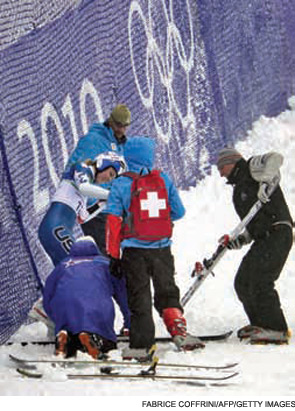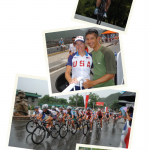
In our society, athletes occupy positions of celebrity and esteem and have become role models so important that their images are enshrined on boxes of Wheaties. Not withstanding Tiger’s big fall from grace, champions from baseball to badminton are touted as heroes for our youth, setting examples for a life in which indomitable spirit overcomes adversity and success goes to the person with the most grit and determination.
While this is a beautiful myth that compels fans to fill stands and watch television until the wee hours of the morning, I think that it is time to give it a rest, especially when it comes to the Olympic Winter Games. If nothing else, the recent spectacle in Vancouver was about risk and danger and could have been an advertisement for the services of orthopedic surgeons. In reality, the essence of the games is contradictory to the goal of preventing musculoskeletal injury and the devastating long-term consequences of traumatic arthritis.

Falls and Injuries Abounded
In the coverage from Vancouver, almost every human-interest story featured an athlete who had suffered serious injury. By a combination of surgery, the ardors of intensive physical therapy, and the support of mom and dad, these athletes had restoration of damaged cartilage, bone, or muscle and, miraculously, could once again fly down the mountain or do helicopter turns of 720 or 1080 degrees while gyrating wildly 30 feet above the chasm walls of an icy track.
After watching falls and crashes in almost every event I turned on, I decided I really didn’t want to expose my rheumatology sensibilities to images of joints being crushed or mangled. Being the dumb sports fan I am, I could not resist finding out whether Lindsey Vonn could again medal in the giant slalom. Vonn had already won a gold and bronze in the downhill and Super G, having somehow recovered from a serious bone bruise immediately before the Olympics. Apparently, she had achieved a cure by pressing soft Austrian cheese to her aching extremity. Whatever that cheese is, I need it in my clinic.
Alas, in the giant slalom, Vonn fell, her ski catching some ice, sending her catapulting into the fence, injuring her hand as it dragged across the ice. As she lay bashed up against the fence, the judges had to wave away the next skier, Julia Mancuso, for fear that if she, too, fell, she would impale Vonn with her poles or behead her with her skis.
After those mishaps, I saw a horrible crash of the German women’s two-person bobsled team, which lost control going about 90 miles an hour. The brake person ejected while the driver stayed in the sled careening upside down along the narrow chute of ice. Horror showed in the faces in the crowd as well as the other sledders as they watched this harrowing event.
In the figure skating, the men and the women fell all over the place. I watched a French man try a quad jump, apparently an important display of athleticism for the men for whom artistry is not enough. Smack to the ice he went, breaking his confidence and perhaps a small patch of cartilage or bone. In the short-track speed skating, two of the leaders got tangled up and went careening into the wall. In the aerials, it seemed that the finale of the big tricks was a horrific tumble.
Even the ads showed falls, with a spot for Visa featuring poor Dan Jansen falling in the 500-meter race in 1988 just after his sister died from leukemia. Fortunately, Jansen came back to win in 1994 in Lillehamer, Norway, the scene of his triumph providing the viewer a reason to feel good about the world and start charging Caribbean vacations with that magic piece of plastic.
Sports is great fun, but it causes an incredible amount of injury for fine young people who, in a few years, will show up in the offices of rheumatologists and orthopedists with chronic pain from post-traumatic osteoarthritis.
Time to Dial Down the Danger?
While the Winter Games are always a dangerous place, it seems that the powers that be want to make them even more dangerous, perhaps to sort out the best athletes or to garner more viewers who like sport to teeter on the edge of catastrophe for the participants. The hills were made steeper, the ice slicker, and the sports themselves more prone to injury. Four wild men bombing down a narrow course in the ski cross is simply asking for trouble.
Watching the women’s giant slalom in a dense fog where the skier could see only a few gates ahead, I had to ask myself, Where are the adults in this activity? Doesn’t anyone care that athletes can get seriously injured or killed when the conditions get too bad or the courses get too steep? Sadly, this Olympics witnessed a fatality when a Georgian luger died during training. In the aftermath, one of the men’s bobsled teams decided not to compete because of their worries about safety. Of course, in the headlines on CNN, these athletes were called “quitters” for making a reasonable decision.
Sports is great fun, but it causes an incredible amount of injury for fine young people who, in a few years, will show up in the offices of rheumatologists and orthopedists with chronic pain from post-traumatic osteoarthritis, the so-called “old knees in young people,” disease. Given the number of serious knee, ankle, and foot injuries that occur as people compete in football, soccer, basketball, skiing, and skating, this epidemic is almost predictable.
Physicians like to talk about prevention but so often the activity that needs prevented is something that people enjoy or will earn them a lot of money. As physicians, we are comfortable cautioning people about smoking, drinking, and unprotected sex. Are we ready to tell them to back off from extreme sports, the rigors of overtraining, and the participation in high-level competition with a badly bruised bone, even if a piece of cheese has quelled the pain for a few days?
The neurologists have sent up the alarm about brain injury in football. While a brain injury is a tragic outcome from collision sports, its frequency is far less than that of musculoskeletal injury from virtually every sport. The Olympics would be just as exciting if the organizers waited until the sun came out or they found a hill that was less steep or they stopped developing sports where survival is as much a goal as victory.
For our ordinary patients, physicians teach about falls prevention. It is a good idea. I hope that, before the next Olympics, rheumatologists as well as our colleagues in orthopedics will be brave and warn of the great hazards that modern sports can inflict on its participants. I like the Olympics as much as anybody, but I find heartbreaking to watch a champion become a cripple for a chance to stand on a podium, chat with Jay Leno, or endorse a cereal, even if it is the Breakfast of Champions.
Dr. Pisetsky is physician editor of The Rheumatologist and professor of medicine and immunology at Duke University Medical Center in Durham, N.C.


